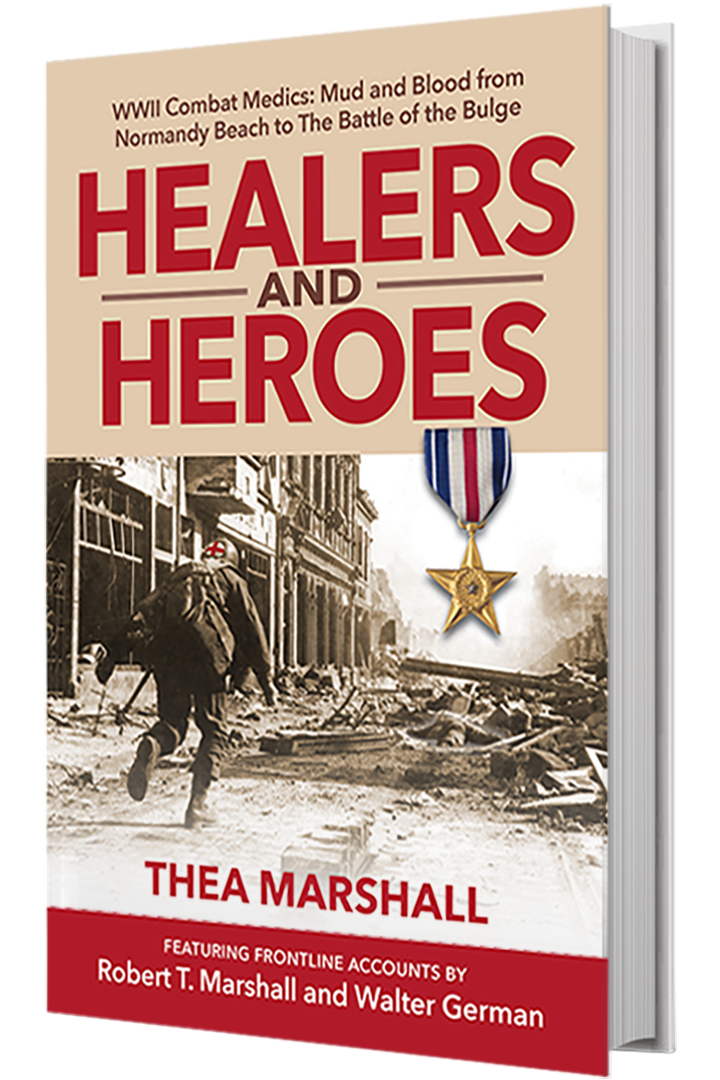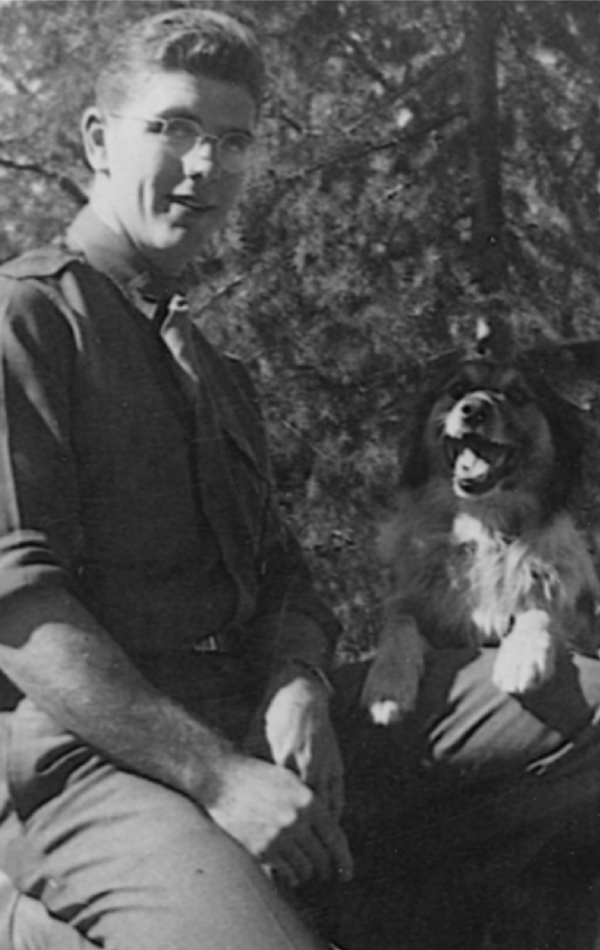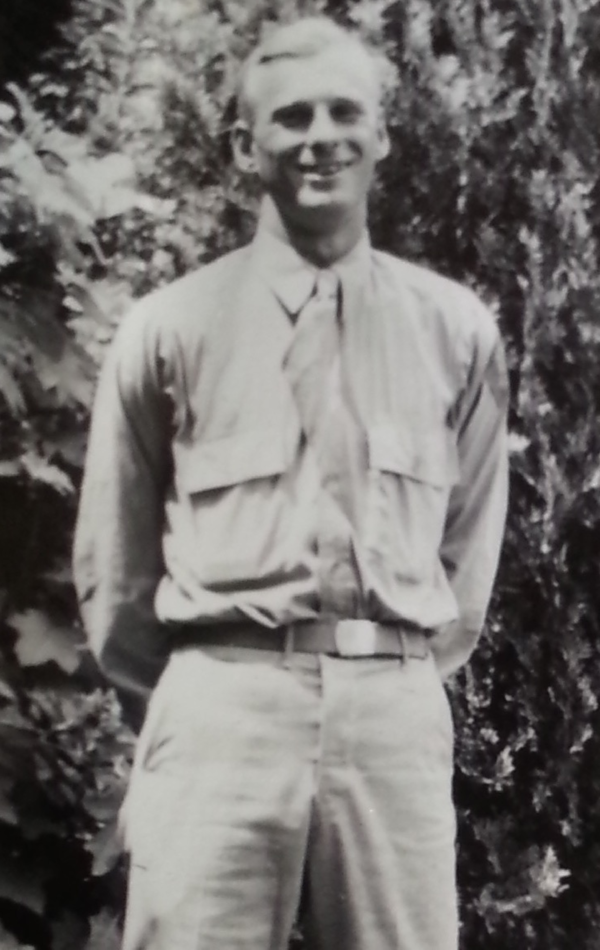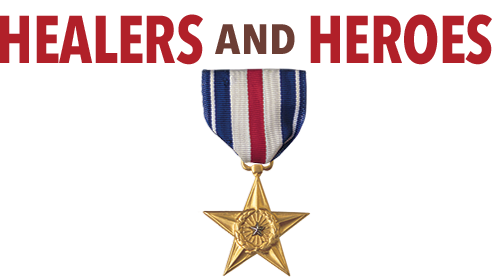

R. T. Marshall in 1945
Soon the day had come in earnest, and with it the casualties started pouring in. Baker Company’s task was merely to clear the Jerries from the other side of Hill 253 and this they accomplished in short order and with a minimum of trouble after the artillery barrage had lifted. The enemy left as many dead and wounded as he had inflicted. We ran the jeep forward to the creek that flowed near the base of the hill and hand-carried the casualties down the hill. Back in the chapel, Bruegge and Geisler were busy passing out plasma and splinting, while the rest of us made it our job to bring them the patients. Lt. Joe Senger, our S-4,[1] dropped in for a visit and was soon put to work hauling wounded from the chapel back to the main aid station.
The trip from the hill wasn’t too bad until the Heinies decided to blast Baker from its heights with artillery. A good many shells would just miss the top and would keep on going down into the valley near the stream straddling our evacuation route. Several shells breezed in as we were getting the last of the GI casualties off the hill. One of these chaps had trench foot and exhaustion so bad that two of the boys were carrying him. We hit the dirt, waited for a breathing spell, and then lit out on the double for the jeep before more shells landed. And who should be leading our pack but the crippled exhaustion case— and he beat us all with his shell-inspired sprinting.
Next we turned to the German casualties. It would have done the Jew-baiting Nazi politicians a world of moral good to see Herbie Scheinberg helping one of their fallen warriors across the be-shelled valley floor to the chapel. Indeed, Herbie picked up a hunk of German shrapnel in his arm from a near hit during one of these excursions. It wasn’t serious and Herbie kept going, but I still like to think about how I once saw a Jew earn a Purple Heart helping save Nazi lives. That’s one for the books!
R. T. Marshall in 1945
Soon the day had come in earnest, and with it the casualties started pouring in. Baker Company’s task was merely to clear the Jerries from the other side of Hill 253 and this they accomplished in short order and with a minimum of trouble after the artillery barrage had lifted. The enemy left as many dead and wounded as he had inflicted. We ran the jeep forward to the creek that flowed near the base of the hill and hand-carried the casualties down the hill. Back in the chapel, Bruegge and Geisler were busy passing out plasma and splinting, while the rest of us made it our job to bring them the patients. Lt. Joe Senger, our S-4,[1] dropped in for a visit and was soon put to work hauling wounded from the chapel back to the main aid station.
The trip from the hill wasn’t too bad until the Heinies decided to blast Baker from its heights with artillery. A good many shells would just miss the top and would keep on going down into the valley near the stream straddling our evacuation route. Several shells breezed in as we were getting the last of the GI casualties off the hill. One of these chaps had trench foot and exhaustion so bad that two of the boys were carrying him. We hit the dirt, waited for a breathing spell, and then lit out on the double for the jeep before more shells landed. And who should be leading our pack but the crippled exhaustion case— and he beat us all with his shell-inspired sprinting.
Next we turned to the German casualties. It would have done the Jewbaiting Nazi politicians a world of moral good to see Herbie Scheinberg helping one of their fallen warriors across the be-shelled valley floor to the chapel. Indeed, Herbie picked up a hunk of German shrapnel in his arm from a near hit during one of these excursions. It wasn’t serious and Herbie kept going, but I still like to think about how I once saw a Jew earn a Purple Heart helping save Nazi lives. That’s one for the books! [1] S-4 is the designation of the logistics section of the battalion headquarters. As with all of the staff sections, the officer in command is also called “the S-4.”
Countdown to Book Release
Day(s)
:
Hour(s)
:
Minute(s)
:
Second(s)

ROBERT T. MARSHALL
U.S. Army Captain
Robert Thomas Marshall (1919-1996), MAC officer in General Patton’s 3rd Army, wrote a narrative of the goings on in his aid station.

WALTER A. GERMAN
U.S. Army Staff Sergeant
